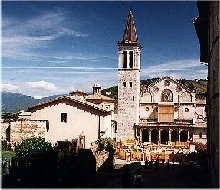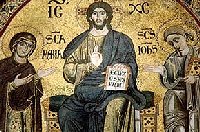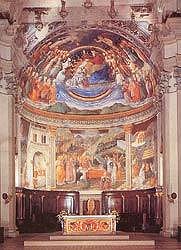 |
| veduta del Duomo |
But the 11th century church that was destroyed by the emperor had also stood on a previous church, built in either the 8th or 9th century, dedicated to St Primiano. All that remains of this church is the crypt under the Cappella delle Reliquie.
The existing façade is the result of a 1200 extension of the previously existing front, adding the two upper exterior rose-windows, the three small rose-windows below, the blind ogival niches and the mosaic at the top. The mosaic is by a certain Solsternus (1207), who preferred the title of “doctor” over the “magister” usually used by artists. The mosaic represents Christ enthroned in the act of blessing, flanked by the Virgin and St John the Baptist.
 |
The bell chamber, designed by Cola da Caprarola, was added between 1512 and 1515.
Next to the main entrance there is the richly carved, walled entrance of the previously existing 9th century cathedral, dedicated to St Primiano.
In 1638 Cardinal Francesco Barberini commissioned Luigi Arrigucci to completely refurbish the interior of the church in the Baroque style, thereby accomplishing also the will of his uncle Pope Urban VIII (Maffeo Barberini), who had been bishop of Spoleto from 1608 to 1617. A bronze bust of the pope by Lorenzo Bernini (1640) is above the entrance within. The Baroque renovations widened the lateral naves and the transept, leaving intact only the Romanesque flooring of the central nave and central apse.
Works carried out in the 19th century employed the neo-Classical architect Giuseppe Valadier, who designed Piazza del Popolo and the Pincio in Rome, to create the altars and doors of the church. Immediately to the right there is the chapel of Bishop Costantino Eroli, which until1845 was used as a baptistery. It contains fine frescoes by Pinturicchio (1497). The adjacent Eroli burial chapel leads to the Cappella dell‘Assunta, started by Costantino Eroli e and completed by his successor Francesco Eroli.
 |
| Abside con affreschi di Filippo Lippi |
There follows the sacristy and then the Cappella della Santissima Icona. This chapel was designed in 1626 by Giovanni Battista Mola and replaced a previously existing chapel. The altar of precious marbles contains the icon for which the chapel was created, an 11th or 12th century Byzantine image on wood of the Madonna, in the Haghiosoritissa mode. The inscription on the edge of the gilded copper border reads that the work was crafted in Byzantium. Frederick Barbarossa gave the work to the city in 1155, as a sign of reconciliation after he had destroyed the cathedral. The central Romanesque apse contains a magnificent cycle of frescoes by Filippo Lippi. His assistants, Fra‘ Diamante and Pier Matteo d‘Amelia, completed the Crib section of the cycle, started by their master and left unfinished when he died. The ‘Annunciation’, ‘Dormitio’ and the ‘Crowning of the Virgin’ are entirely by these two pupils..
Like the other altars in the church, the high altar was designed by Valadier and donated by Pope Pius VI. The four columns are in eastern granite.
The Cappella del Sacramento, to the left of the presbytery, was built at the end of the 16th century and decorated two centuries later. The Cappella di Sant’Anna is 14th century and was entirely decorated with frescoes in 1597. During the works to enlarge the building in 1644, the chapel was cut. At the end of the 19th century the frescoes were removed to show the previous 14th and 15th century decoration.
The Cappella delle Reliquie gives onto the left hand nave. It was added in 1540 to house the icon and other precious vestments in inlaid cupboards. Only the face of the cupboards remain since the remaining sections were used to make the pews of the choir. The wooden sculptures and the altar backing are both by Giovanni Andrea di Ser Moscato and Damiano di Mariotto (1545-54).
The niche of the left hand nave after the altars designed by Valadier contains one of the most important works of the entire Duomo: the ”Crucifix on painted parchment and applied to wood by Alberto So[tii] (1187). This came from the church of San Giovanni e San Paolo, where a number of frescoes by disciples of this master have been brought to light.
A number of important documents are kept in the Archivio Capitolare, including the finely illuminated ‘Leggendari’ of St Felice of Narco (12th century) and of St Brizio (13th century). There is also a letter from St Fancis to Brother Leone, written by the saint himself, from San Simone.








